![[Snakeroot Organic Farm logo]](pix/sof.gif)
At dawn
Canoe bow waves are quickly lost
on the shoreside
But go on out of sight
on the lake side.
-1986
The constant swish-swish of skis
On a day long ski.
The constant swish-swish of wiper blades
On a day long drive.
-1990
My dog, trotting barefoot
Steps on a garden slug
And thinks
Nothing of it.
-1999
Word spreads quickly
as I approach the pond.
All becomes quiet.
-1997
Hidden in the vines
a large warted cucumber
jumps out of reach.
A toad!
-1997
Delicate puffs
of marshmallow snow
carefully perched
on a branch,
await the trigger of my hat
to melt their way down my back.
-2010
Deep in the tomato jungle
Fruits of yellow, purple and red
Tell of their readiness
To go to market.
-2010
Sugarin' Chores
Snowflakes hurry through my flashlight beam,
As my boots knead new snow with spring mud,
On my nightly Hajj to keep the boil alive,
For as long as possible until the dawn,
To match the power of the flowing sap,
With my meager evaporator and will.
The prize at the finish line are jars of syrup
And Spring.
-2013
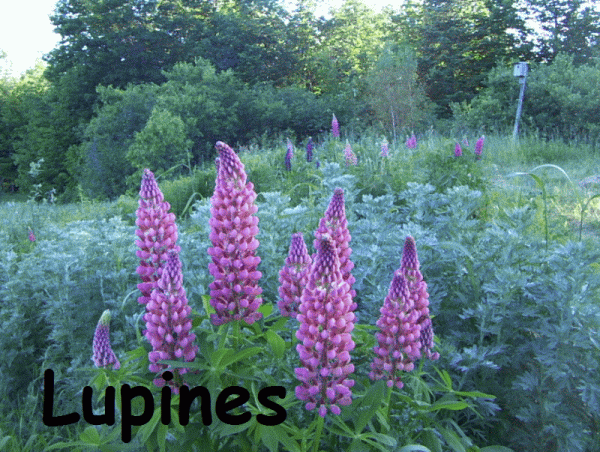
COLORS The commonest color of lupines found in the wild along roadsides are blues, purples and whites. By contrast, Snakeroot Organic Farm offers lupines of the the Russell Extra Choice strain (Lupinus Polyphyllus) with a full range of brilliant lupine colors all the way from white, pink, violetblue, red, rose, yellow, peach, salmon and many splendid bi-color combinations in spectacular spires of color. The Russell Strain was originally developed through extensive selection and hybridization around 1935 by George Russell, a railroad crossing guard in Yorkshire, England. Lupines are perennials which blossom in June every year starting the second year and continue doing so for many years. Some plants, when started from seed early enough in the spring, will flower in late summer of their first year, but normally the first blossoms appear in June of the second year. Each blossom on a lupine flower spike is made up of two parts, which can be the same or different colors, allowing for a wide variety of color variations. Each plant will send up the same color flowers year after year. Flower spires of established plantings are over a foot long and after several years plants send up multiple flower spikes resulting in a longer blooming season. Individual plants usually live from five to twenty years, dropping seeds around them in early August after June flowering. GROWING CONDITIONS Lupines like a moist area with good drainage. They do not like wet feet, so never plant them where there is standing water or where ferns or moss grows. Well drained banks and hillsides make excellent locations. Lupines are very hardy, and like full sun to partial shade. Do not mulch lupines for the winter! They do not require mulch as they are very winter hardy and mice may live in the mulch and gnaw your lupine roots. Hardy from zone 4 (central Maine) thru Zone 8 (Florida), Lupines thrive on ample moisture. In full sun lupines grow better and bloom earlier. A cold dormant season produces more prolific flowering. PLANT HABIT Lupines have a root similar to a dandelion consisting of a fleshy "taproot" with a few big prongs. Each Lupine will grow larger over the years and soon send up from half a dozen to twenty flower stalks. A bed of Lupines typically flower the entire month of June. Bumblebees love lupines, but unfortunately so do slugs and aphids. Slugs can be picked off at dawn or dusk or on rainy days, or can be trapped under boards or shingles left near the lupines. Aphids may be mechanically removed with a strong spray from the garden hose, or killed by spraying them with a soap (not detergent!) and water solution. Lupines are a legume, related to beans, peas, carob, peanuts, honeylocusts, vetch and clover. They often have nodules of beneficial nitrogenfixing bacteria growing on their roots, which help the plant grow by turning nitrogen from the air into nitrates the plant can use. This allows lupines to grow vigorously in otherwise poor soils. Lupines actually improve the soils they grow in. Individual lupines plants do not spread. As they get older the root gets bigger and sends up more flower stalks. Lupines, do, however, produce dozens of pealike seeds per plant, which are dispersed when the pods pop open in late July or early August. This results in many lupine seedlings surrounding the mother plant the following spring. The quickest and easiest way to rapidly expand your lupine bed is to save your own seeds, a practice which will yield fifty to a hundred times more lupine seedlings than by letting nature take its course unaided. An overview of the process: Gather seed pods, open them when dry, and plant the seeds in November or March in a nursery bed where they will remain their first year, then transplant them to their home. In detail: Cut the entire seed stalk when the seed pods have turned black, but before they have begun to pop open and curl. Collect these seed stalks in a paper bag, and set them aside to dry for a month or so. When dry, break the seeds out of the pods, and plant them in a nursery garden in late fall or early spring. This nursery garden is where the lupines will grow for their first year, so it is alright if they are spaced closely, say two or three inches apart. First year lupines are tiny plants, so haveing many in a small area allows them to be easily watched over and taken care of. When their second spring arives, dig each root as the leaves begin to sprout (late April thru mid May) and plant it where you want it to live. Check your nursery garden every few days for more roots that have awakened. The lupines will now grow to large plants and blossom every June. Seedlings from any plant will result in colors ranging from the color of the mother plant to the colors of the other lupines in the area. Only rarely will all of the seedlings from the mother plant have the same coloring as the mother plant. Even if there are no other lupines in the area, the genetic makeup of the mother plant may include colors which only get expressed in her offspring. If you live in an otherwise lupine-free area, you can do your own color selection by only allowing the lupine colors you want to produce seed. Break off the other colors as soon as they have gone by. Lupine-free areas are those where there are no other lupines within a mile, since honeybees and bumble bees will travel that far and mix up the pollen on you. WHERE TO PLANT LUPINES Instead of running the lawn mower along steeply sloping banks in your lawn, consider planting lupines there. Not only will the slope provide an excellent display for your lupines, but it will save you from ever having to mow that tricky area again. With a height of 30"42", lupines make good backdrops for a flower garden. They do well against a house, even if the rain from the eaves regularly gives them a good dousing. Lupines naturalize easily. Gravel banks along driveways can be transformed into lowmaintenance flower gardens whose blooms will be the talk of the neighborhood. HOW TO ESTABLISH A PLANTING Lupine plantings are lowmaintenance. As you can tell by the wild varieties found along the sides of country roads, lupines do just fine with zero maintenance. However, lupines will benefit by spreading some lime, manure or compost around the plants in the spring. You can begin by simply digging a hole twice as big as the root ball, planting it no deeper than it was originally, and at least a foot apart. Add a little compost and lime if the soil is poor and lupines will need no further encouragement. Disturb the roots as little as possible when transplanting. "Why not just dig up a wild lupine whose color I want?" There are several reasons. While this may indeed work ocassionally, more commonly is does not. This is because the very worst time to transplant any flower is when it is in bloom. Producing flowers, pollen and seed is expensive for a plant, and it requires all of its stored up resources to do properly. When you dig up a wild lupine, you will invariably be severing many of the large roots it has established over perhaps five to ten years of growth, leaving it with fewer resources than it planned on having when it started to blossom. Since seeds are very important to a plant, the lupine will do all it can to assure the survival of the offspring, to the detriment of the mother plant. This is why so few wild-dug lupines survive to flower a second season. In late May each year, we begin bringing our potted lupines to market, just before they begin to bloom. During the entire month of June we have pots of blooming lupines for sale at the farmers' markets we attend, as well as at the farm. Visitors to the farm get to choose from our entire collection of potted lupines, and view all the lupines we have planted about the farm. Pots are from 6 inches to 12 inches in size, depending upon the size of the lupine roots that went into the pots, and are ready to transplant. Blooming Lupines in pots: $8 each, 3 pots for $20, your choice of colors. Baby lupines started from seed this year, will bloom next June: $1 per pot, or 12 pots for $10. You'll find out what colors these are next June. Our Own Seed: Packets of our own organically grown lupine seed are also available, collected from mother plants in August each year. $1 each pkt. (1 tsp seeds, mixed colors) |
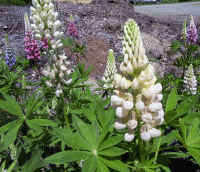 |
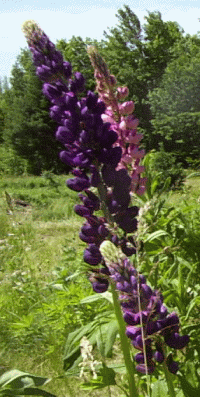 | |
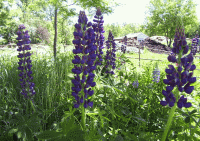 | |
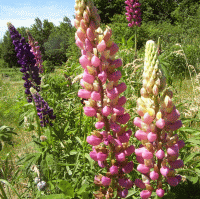 | |
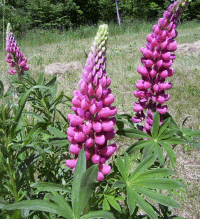 | |
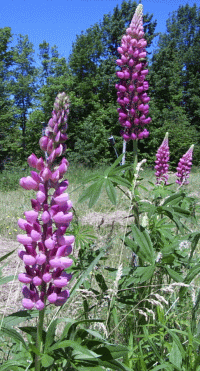 | |
 | |
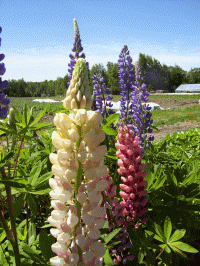 | |
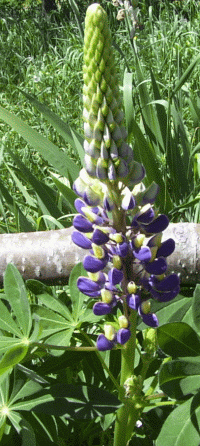 | |
 | |
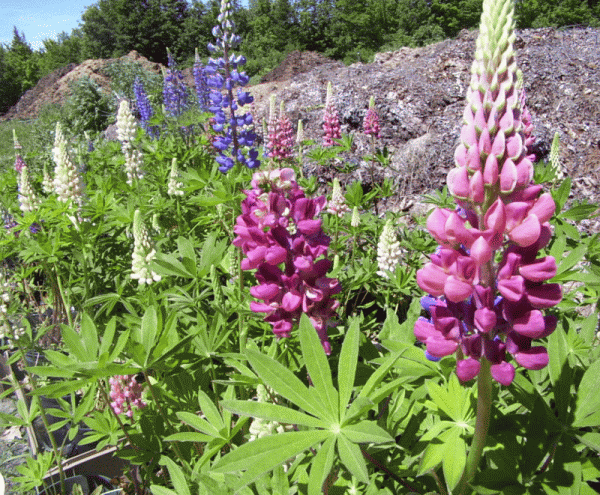 |
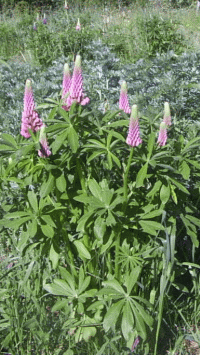 |
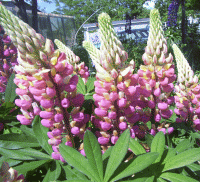 |
 27 Organic Farm Road, Pittsfield Maine 04967 http://www.snakeroot.net/farm owned and operated by Tom Roberts & Lois Labbe Tom: Tom@snakeroot.net (cell) 207-416-5417 or Lois: Lois@snakeroot.net (cell) 207-416-5418 Gardening for the public since 1995. |
|
|

